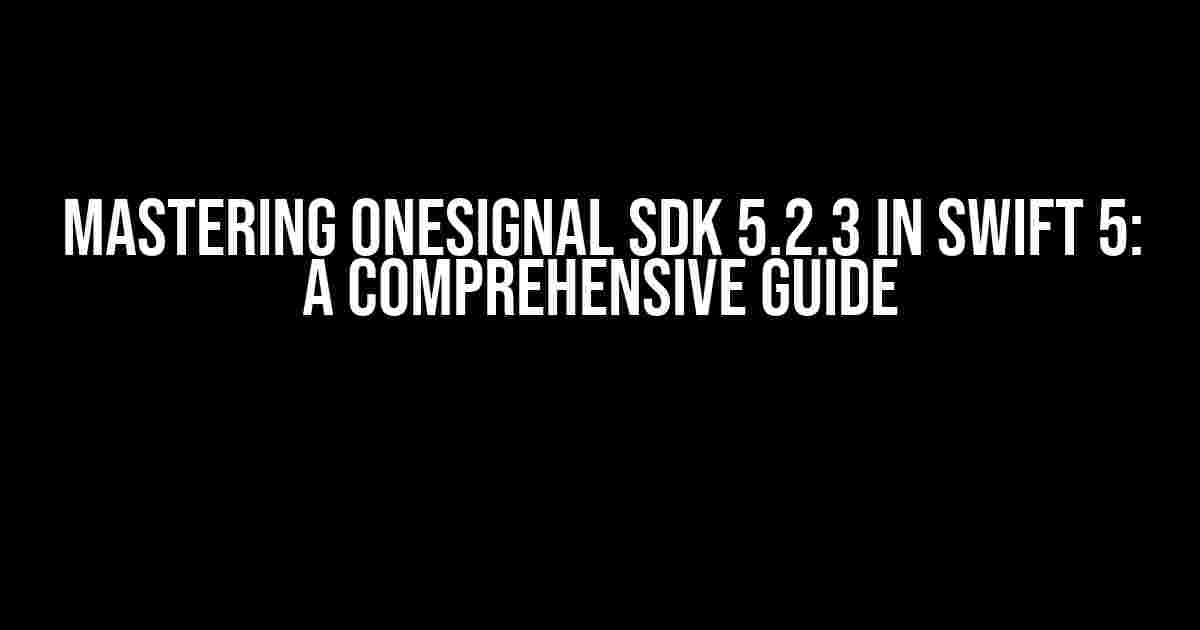Are you tired of struggling with OneSignal SDK 5.2.3 in Swift 5? Do you need help integrating this powerful notification tool into your iOS app? Look no further! This article will walk you through the process of setting up and utilizing OneSignal SDK 5.2.3 in Swift 5, providing clear and direct instructions to get you up and running in no time.
Prerequisites
Before we dive in, make sure you have the following:
- Xcode 12.0 or later
- Swift 5.0 or later
Step 1: Install OneSignal SDK via CocoaPods
CocoaPods is the recommended way to install OneSignal SDK. Open your terminal and navigate to your project directory:
cd /path/to/your/projectThen, add the following code to your Podfile:
pod 'OneSignal', '5.2.3'Run the following command to install the pod:
pod installOpen the generated `.xcworkspace` file in Xcode.
Step 2: Initialize OneSignal
In your AppDelegate.swift file, import OneSignal and initialize it in the `application(_ application: UIApplication, didFinishLaunchingWithOptions launchOptions: [UIApplication.LaunchOptionsKey: Any]?) -> Bool` method:
import OneSignal
func application(_ application: UIApplication, didFinishLaunchingWithOptions launchOptions: [UIApplication.LaunchOptionsKey: Any]?) -> Bool {
// OneSignal Initialization
let onesignalInitSettings = [kOSiOSSettingsKeyAutoPrompt: true, kOSiOSSettingsKeyInAppLaunchURL: false]
OneSignal.initWithLaunchOptions(launchOptions, appId: "YOUR_APP_ID", handleNotificationAction: nil, settings: onesignalInitSettings)
OneSignal.setLogLevel(.LL_VERBOSE, visualLevel: .LLNONE)
return true
}Replace `YOUR_APP_ID` with your actual OneSignal App ID.
Step 3: Request Push Notification Permission
In the same `application(_ application: UIApplication, didFinishLaunchingWithOptions launchOptions: [UIApplication.LaunchOptionsKey: Any]?) -> Bool` method, add the following code to request push notification permission:
UNUserNotificationCenter.current().requestAuthorization(options: [.alert, .sound, .badge]) { granted, error in
if granted {
print("Notification permission granted")
} else {
print("Notification permission denied")
}
}Step 4: Handle Push Notifications
Implement the following methods to handle push notifications:
func userNotificationCenter(_ center: UNUserNotificationCenter, didReceive response: UNNotificationResponse, withCompletionHandler completionHandler: @escaping () -> Void) {
let userInfo = response.notification.request.content.userInfo
OneSignal.didReceiveNotificationExtension(userInfo: userInfo)
completionHandler()
}
func userNotificationCenter(_ center: UNUserNotificationCenter, willPresent notification: UNNotification, withCompletionHandler completionHandler: @escaping (UNNotificationPresentationOptions) -> Void) {
let userInfo = notification.request.content.userInfo
OneSignal.willPresentNotificationExtension(userInfo: userInfo)
completionHandler([.alert, .sound, .badge])
}Step 5: Send Test Notification
To verify that everything is set up correctly, send a test notification from the OneSignal dashboard:
| Step | Action |
|---|---|
| 1 | Login to your OneSignal account and go to the Messages tab. |
| 2 | Click the “New Message” button. |
| 3 | Enter a message title and message text. |
| 4 | Select “Test Message” as the message type. |
| 5 | Click the “Send” button. |
If everything is set up correctly, you should receive the test notification on your device.
Troubleshooting
If you encounter any issues during the setup process, refer to the following troubleshooting steps:
- Check your OneSignal App ID and API Key for accuracy.
- Verify that you have correctly installed the OneSignal SDK via CocoaPods.
- Ensure that you have initialized OneSignal correctly in your AppDelegate.swift file.
- Check your notification permission status and request permission again if necessary.
- Contact OneSignal support if none of the above steps resolve the issue.
Conclusion
By following this comprehensive guide, you should now have OneSignal SDK 5.2.3 integrated into your Swift 5 iOS app. With push notifications, you can enhance user engagement and re-encourage users to interact with your app. If you have any further questions or need additional assistance, don’t hesitate to reach out to the OneSignal community or support team.
Happy coding, and happy notifying!
Frequently Asked Question
Get the answers you need to navigate the OneSignal SDK 5.2.3 in Swift 5!
How do I integrate OneSignal SDK 5.2.3 into my Swift 5 project?
To integrate OneSignal SDK 5.2.3 into your Swift 5 project, start by adding the OneSignal pod to your Podfile. Then, run `pod install` to install the SDK. Next, import OneSignal in your AppDelegate, and initialize it with your app’s ID and API key. Finally, add the necessary permissions to your Info.plist file.
What is the minimum iOS version required for OneSignal SDK 5.2.3?
The minimum iOS version required for OneSignal SDK 5.2.3 is iOS 10.0.
How do I handle push notifications in the foreground with OneSignal SDK 5.2.3?
To handle push notifications in the foreground with OneSignal SDK 5.2.3, implement the `OneSignalDelegate` protocol in your AppDelegate, and override the `didReceiveNotification` method. This method will be called when a push notification is received while the app is in the foreground.
Can I customize the appearance of push notifications with OneSignal SDK 5.2.3?
Yes, you can customize the appearance of push notifications with OneSignal SDK 5.2.3 by using the `OneSignal.setNotificationWillShowInForegroundHandler` method to set a custom notification handler. This allows you to control the notification’s title, message, and other attributes.
Why am I not receiving push notifications with OneSignal SDK 5.2.3?
If you’re not receiving push notifications with OneSignal SDK 5.2.3, check that you’ve enabled push notifications in your Xcode project, and that you’ve added the necessary permissions to your Info.plist file. Also, make sure you’ve initialized OneSignal correctly, and that you’re using the correct app ID and API key.

